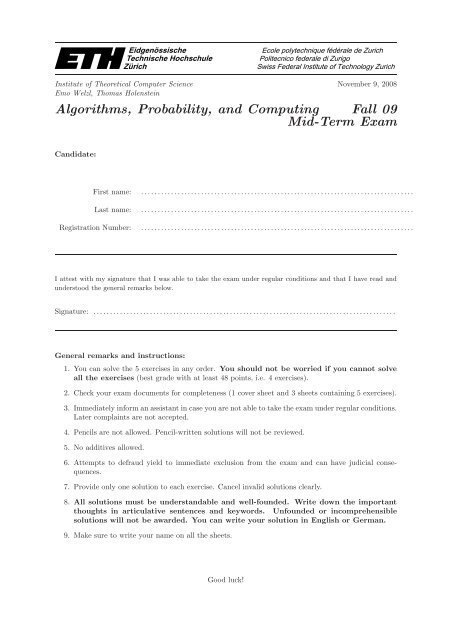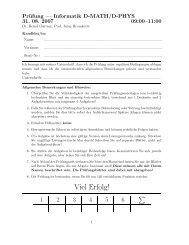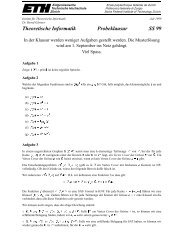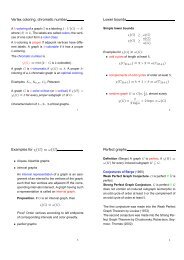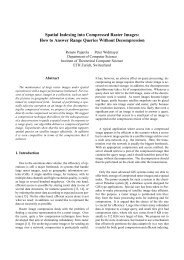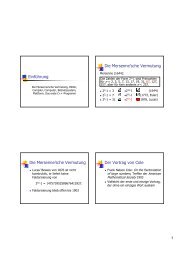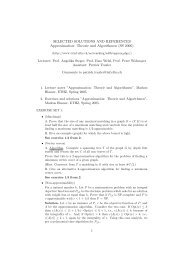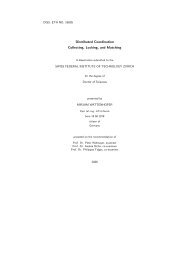Algorithms, Probability, and Computing Fall 09 Mid-Term Exam
Algorithms, Probability, and Computing Fall 09 Mid-Term Exam
Algorithms, Probability, and Computing Fall 09 Mid-Term Exam
You also want an ePaper? Increase the reach of your titles
YUMPU automatically turns print PDFs into web optimized ePapers that Google loves.
Eidgenossische ¨<br />
Technische Hochschule<br />
Zurich ¨<br />
Ecole polytechnique federale ´ ´ de Zurich<br />
Politecnico federale di Zurigo<br />
Swiss Federal Institute of Technology Zurich<br />
Institute of Theoretical Computer Science November 9, 2008<br />
Emo Welzl, Thomas Holenstein<br />
<strong>Algorithms</strong>, <strong>Probability</strong>, <strong>and</strong> <strong>Computing</strong> <strong>Fall</strong> <strong>09</strong><br />
<strong>Mid</strong>-<strong>Term</strong> <strong>Exam</strong><br />
C<strong>and</strong>idate:<br />
First name: . .................................................................................<br />
Last name: . .......................................... . ......................................<br />
Registration Number: . ................................ .................................................<br />
I attest with my signature that I was able to take the exam under regular conditions <strong>and</strong> that I have read <strong>and</strong><br />
understood the general remarks below.<br />
Signature: . ..........................................................................................<br />
General remarks <strong>and</strong> instructions:<br />
1. You can solve the 5 exercises in any order. You should not be worried if you cannot solve<br />
all the exercises (best grade with at least 48 points, i.e. 4 exercises).<br />
2. Check your exam documents for completeness (1 cover sheet <strong>and</strong> 3 sheets containing 5 exercises).<br />
3. Immediately inform an assistant in case you are not able to take the exam under regular conditions.<br />
Later complaints are not accepted.<br />
4. Pencils are not allowed. Pencil-written solutions will not be reviewed.<br />
5. No additives allowed.<br />
6. Attempts to defraud yield to immediate exclusion from the exam <strong>and</strong> can have judicial consequences.<br />
7. Provide only one solution to each exercise. Cancel invalid solutions clearly.<br />
8. All solutions must be underst<strong>and</strong>able <strong>and</strong> well-founded. Write down the important<br />
thoughts in articulative sentences <strong>and</strong> keywords. Unfounded or incomprehensible<br />
solutions will not be awarded. You can write your solution in English or German.<br />
9. Make sure to write your name on all the sheets.<br />
Good luck!
achieved points (maximum) reviewer’s signature<br />
1 (12)<br />
2 (12)<br />
3 (12)<br />
4 (12)<br />
5 (12)<br />
Σ (60)
Exercise 1<br />
We consider a r<strong>and</strong>om search tree for the elements {1, . . ., n} for n ≥ 3. Let p (1)<br />
n denote the probability<br />
that the descendants of element 1 are exactly the elements 1, 2 <strong>and</strong> 3, i.e. no further elements are<br />
descendants of 1.<br />
(a) Compute p (1)<br />
n for n = 3 <strong>and</strong> n = 4.<br />
(b) Set up a recurrence for p (1)<br />
n <strong>and</strong> solve the recurrence. Remark: Do not be tempted to solve (b) by<br />
first solving (c). You have to solve (b) via the recurrence method.<br />
(c) For n ≥ 5 <strong>and</strong> 2 ≤ i ≤ n − 3, consider the indicator variable<br />
Ei := [the descendants of i are exactly i, i + 1, <strong>and</strong> i + 2] .<br />
Express Ei in terms of the indicator variables A i j<br />
A i j<br />
from the lecture notes. These where defined as<br />
:= [i is an ancestor of j] .<br />
(d) Compute E[Ei]. Warning: the events Ai j you used for solving (c) are most likely not independent.
Exercise 2<br />
You are given five elements with the following keys <strong>and</strong> priorities:<br />
key priority<br />
1 0.9<br />
2 0.3<br />
4 0.6<br />
5 0.2<br />
6 0.5<br />
(a) Draw the treap according to the given keys <strong>and</strong> priorities. Reminder: we consider min-heaps, i.e.<br />
the root is the element with the smallest priority (i.e., here the element with key 5 <strong>and</strong> priority<br />
0.2).<br />
(b) Insert the element 3 with priority 0.4 into this treap: draw the treap after insertion, but before<br />
any rotation (i.e., here, the element with key 3 is a leaf). Then draw the treap after each rotation,<br />
until 3 is at its final position.<br />
(c) Suppose we insert the element with key 3 not with priority 0.4, but with priority p ∈u.a.r. [0, 1].<br />
What is the probability that after insertion <strong>and</strong> all subsequent rotations, its depth is 1? Justify<br />
your answer.
Exercise 3<br />
Consider the triangle T := conv({p, q, r}) in the picture below <strong>and</strong> the three dual lines p ∗ , q ∗ , <strong>and</strong> r ∗ .<br />
Recall that for a point p = (a, b), its dual p ∗ is the line ax − b, <strong>and</strong> the dual of a line ℓ : ax + b is the<br />
point ℓ ∗ = (a, −b). We call a line nice if it contains at least one of the three vertices p, q, <strong>and</strong> r, but also<br />
contains at least one more point from T. For example, the horizontal line through r is nice, <strong>and</strong> so is<br />
the line connecting p <strong>and</strong> q. The horizontal line through q is not nice.<br />
r<br />
(a) Draw a line into the left picture below that is not nice <strong>and</strong> intersects the interior of the triangle.<br />
(b) Draw the set of duals of all nice lines, i.e. the set<br />
<strong>and</strong> give a short explanation of your answer.<br />
p<br />
q<br />
{ℓ ∗ | ℓ is a nice line} ,<br />
p ∗<br />
r ∗<br />
q ∗
Exercise 4<br />
You are given a convex polygon C with vertices p1, . . . , pn. We define a scaled version of C as follows:<br />
For λ ∈ R + 0 , we define the set<br />
λC := conv({λp1, . . . , λpn}) ,<br />
where λpi simply denotes scalar multiplication in R 2 . We are now interested in the following problem:<br />
Given a point q ∈ R, find the smallest λ ∈ R + 0 such that q ∈ λC. We call that value λC(q). Note that<br />
such a λ does not always exist.<br />
(a) Draw an example of a polygon C <strong>and</strong> a point q such that there is no λ ∈ R + 0 such that q ∈ λC.<br />
You probably want to draw x-axis <strong>and</strong> y-axis as well.<br />
(b) Draw an example of a polygon C <strong>and</strong> a point q where q ∈ C <strong>and</strong> λC(q) < 1.<br />
(c) Design a preprocessing/query algorithm doing the following: On query q, it computes λC(q) in<br />
time O(log n), outputs impossible if no such λ exists. Your data structure should use no more<br />
than O(n) space. You can assume that p1, . . .,pn describe the vertices of the polygon in counterclockwise<br />
order. For simplicity, you may assume that the origin (0, 0) does not lie on the boundary<br />
of C, <strong>and</strong> that no edge of C lies on a line with the origin.
Exercise 5<br />
Consider the following network <strong>and</strong> its flow. Please note that the numbers 4/5 <strong>and</strong> so on are not fractions:<br />
the 4/5 on the edge from s to u does not read “four fifths”, but indicates that this is an edge of capacity<br />
5, <strong>and</strong> the current flow at this edge has value 4.<br />
s<br />
4/5<br />
(a) What is the value of the flow?<br />
(b) Draw the residual network.<br />
x<br />
3/4<br />
3/3 0/2 2/3<br />
u<br />
(c) Simulate Ford-Fulkerson on this network: Perform several augemtation steps, starting with the<br />
flow drawn above, until you find a maximum flow. In each step, clearly say which augmenting<br />
path you are using, <strong>and</strong> draw the flow after augmenting. For this, you can use the copies of the<br />
network that are printed below by filling in the flow values.<br />
(d) Give a min cut of this network, i.e. a set S of vertices containing s but not t minimizing cap(S).<br />
y<br />
2/3<br />
1/2<br />
v<br />
2/3<br />
t
s<br />
s<br />
/5<br />
x<br />
/3 /2 /3<br />
/5<br />
x<br />
/4<br />
/4<br />
u<br />
y<br />
/3<br />
/2<br />
/3 /2 /3<br />
u<br />
y<br />
/3<br />
/2<br />
v<br />
v<br />
/3<br />
/3<br />
t<br />
t<br />
s<br />
s<br />
/5<br />
x<br />
/4<br />
/3 /2 /3<br />
/5<br />
x<br />
/4<br />
u<br />
y<br />
/3<br />
/2<br />
/3 /2 /3<br />
u<br />
y<br />
/3<br />
/2<br />
v<br />
v<br />
/3<br />
/3<br />
t<br />
t


